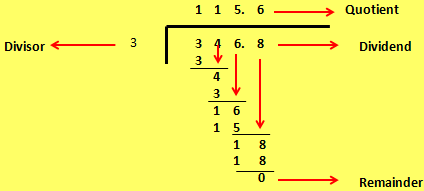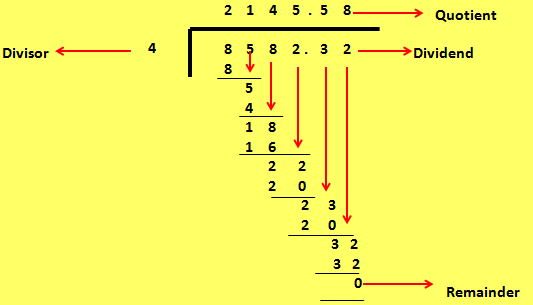Division of Decimal Fractions by Multiples
This topic would deal with division of decimals by multiples. That means we need to divide decimal fractions by multiples of 10 like 10, 20, 30. 40, 50……etc. Or division by multiples of 100 that is 100, 200, 300, 400, 500,…. and likewise. In case of division by the multiple of 1000 the division would be like 1000, 2000, 3000 and so on. We will learn about each of them.
For example:
346.8 ÷ 30
Solution:
346.8 ÷ 30
= 346.8/30
This can also be written as
= 346.8/(3 × 10)
We can also write it as;
= (346.8/3) × (1/10)
Now we will divide 346.8 by 3 first
= 115.6
Now, 115.6 × (1/10)
Now since it is actually division by 10 the decimal point will move 1 place to the left. Hence the decimal will be placed after 11. That means
= 11.56
Here are few more examples to illustrate the division of decimal fractions by multiples
1. 8582.32 ÷ 400
Solution:
8582.32 ÷ 400
= 8582.32/400
= 8582.32/ (4 × 100)
= (8582.32/4) × (1/100)
Now we will divide 8582.32 by 4 first
= 2145.58
Now, 2145.58 × (1/100)
=it is actually division by 100 the decimal point will move 2 places to the left. Hence the decimal will be placed after 1. That means
= 21.4558
2. 28984.25 ÷ 5000
Solution:
28984.25 ÷ 5000
= 28984.25/5000
= 28984.25 / (5 × 1000)
= 28984.25/5 × (1/1000)
So, first divide 28984.25 by 5
= 5796.25
Therefore, now 5796.25 × (1/1000)
That is actually 5796.25 divided by 1000. As there are three zeros in thousand hence the decimal point will move three places to the left. That is
= 5.79625
3. 771.84 ÷ 600
Solution:
771.84 ÷ 600
= 771.84/600
= 771.84 / (6× 100)
= 771.84/6 × (1/100)
Hence we need to first divide 771.84 by 6
= 128.64
Now we actually need to divide 128.64 by 100 and hence the decimal point will move 2 places to the left as there are 2 zeros in 100. That is
= 1.2864
4. 96.35 ÷ 50
Solution:
96.35 ÷ 50
= 96.35/50
= 96.35/ (5 × 10)
= 96.35/5 × (1/10)
Now we will first divide 96.35 by 5
= 19.27
Now we need to divide 19.27 by 10. The decimal point will move one place to the left. That is the answer will be
= 1.927
5. 170.46 ÷ 300
Solution:
170.46 ÷ 300
= 170.46/300
= 170.46/ (3 × 100)
= 170.46/3 × (1/100)
Hence first we need to divide 170.46 by 3
= 56.82
Now we need to actually divide 56.82 by 100. There are 2 zeros in 100 hence the decimal point will move 2 places to the left. That is the answer will be
= 0.5682
In this way we can solve these divisions by multiples by first dividing the decimal with whole number and then with the answer by 10, 100 or 1000 as asked in the question
From Division of Decimal Fractions by Multiples to HOME PAGE
Recent Articles
-
Eleventh Grade | Eleventh Grade Science | Eleventh Grade Math
Jun 27, 25 12:26 AM
Eleventh grade biology has been designed in accordance with the recommended topics. We will cover all the topics in biology very exciting and interesting way. -
Explain Digestion of Food | Salivary Glands | Oesophagus | Stomach
Jun 27, 25 12:20 AM
Before the digestion is start by the different enzymes secreted from the different digestive glands food must be turned and chut or mixed with saliva inside the mouth. -
Explain Human Digestive System | Mouth | Tongue | Pharynx | Teeth
Jun 21, 25 01:15 PM
Digestive system is a system of alimentary canal and digestive glands. Alimentary canal- alimentary canal is a tube of variable diameter having muscular wall and glandular epithelial tissues which sta… -
Vernalisation in Plants | Definition | Mechanism | Devernalization |
Jun 18, 25 01:34 PM
Definition of vernalisation- The change of flowering habit due to the low temperature treatment is known as vernalisation. This is a physiological process which was denoted by Clipart in 1857 invite b… -
The Food We Eat | Food we Get from Plants and Animals | Carbohydrates
Jun 15, 25 03:20 PM
What are the food that we should eat? Find out the names of ten food items in the word maze. Write the names in the correct column of the table given below. Food we get from plants Food we get from an…










New! Comments
Have your say about what you just read! Leave me a comment in the box below.